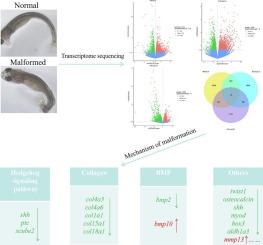转录组测序揭示了濒临灭绝的四川台鱼早期畸形的分子机制
IF 2.2
2区 生物学
Q4 BIOCHEMISTRY & MOLECULAR BIOLOGY
Comparative Biochemistry and Physiology D-Genomics & Proteomics
Pub Date : 2025-09-17
DOI:10.1016/j.cbd.2025.101639
引用次数: 0
摘要
胡竹是中国一级保护物种。近年来,很少有野生布利克瑞的记录被记录下来。因此,人工繁殖已成为保护该物种的最后手段。然而,在幼虫培养阶段,大量个体出现形态异常,占死亡幼虫的大多数。在这项研究中,我们对正常和畸形鱼在三个不同的发育阶段:孵化后4天(dph)、15天(dph)和31天(dph)进行了转录组测序,并探索了与骨骼发育相关的关键差异表达基因(DEGs)的表达模式。转录组测序在4 dph、15 dph和31 dph时,对照组和畸形组分别鉴定出3024、2678和7088个deg。基因集富集分析显示,细胞发育、细胞骨架组织调控、TGF-β信号通路、Wnt信号通路富集分数较高。参与骨骼发育的基因,包括shh、daam1、骨连接素、twist1、骨钙素、col1a1、myod和hox3,在畸形鱼中显著下调,而mmp13和TGFβ显著上调。值得注意的是,Hedgehog信号通路的关键基因在畸形组中均被抑制,表明它们在H. bleekeri正常骨骼发育中起着至关重要的作用。这项研究增强了我们对鱼类骨骼调节的潜在机制的理解,并可能有助于减少H. bleekeri畸形的发生率。本文章由计算机程序翻译,如有差异,请以英文原文为准。

Transcriptome sequencing reveals the molecular mechanisms of early malformations in the critically endangered Sichuan taimen (Hucho bleekeri)
Hucho bleekeri is a Class I protected species in China. In recent years, very few records of wild H. bleekeri have been documented. Therefore, artificial breeding has become the last resort to protect this species. However, during the larvae cultivation phase, a large number of individuals exhibit abnormal morphology, which constitute the majority of dead larvae. In this study, we conducted transcriptome sequencing on normal and malformed fish at three distinct developmental stages: 4 days post-hatching (dph), 15 dph, and 31 dph, and explored the expression patterns of key differentially expressed genes (DEGs) associated with skeletal development. Transcriptomic sequencing identified a total of 3024, 2678, and 7088 DEGs in the control versus malformed groups at 4 dph, 15 dph, and 31 dph, respectively. Gene Set Enrichment Analysis showed that cell development, regulation of cytoskeleton organization, TGF-β signaling pathway, and Wnt signaling pathway, had relatively high enrichment scores. Genes involved in skeletal development, including shh, daam1, osteonectin, twist1, osteocalcin, col1a1, myod, and hox3, were significantly down-regulated in malformed fish, while mmp13 and TGFβ were significantly up-regulated. Notably, key genes in the Hedgehog signaling pathway were all inhibited in the malformed groups, indicating their crucial roles in the normal skeletal development of H. bleekeri. This study enhances our understanding of the underlying mechanisms of skeletal regulation in fish and may help reduce the incidence of malformations in H. bleekeri.
求助全文
通过发布文献求助,成功后即可免费获取论文全文。
去求助
来源期刊
CiteScore
5.10
自引率
3.30%
发文量
69
审稿时长
33 days
期刊介绍:
Comparative Biochemistry & Physiology (CBP) publishes papers in comparative, environmental and evolutionary physiology.
Part D: Genomics and Proteomics (CBPD), focuses on “omics” approaches to physiology, including comparative and functional genomics, metagenomics, transcriptomics, proteomics, metabolomics, and lipidomics. Most studies employ “omics” and/or system biology to test specific hypotheses about molecular and biochemical mechanisms underlying physiological responses to the environment. We encourage papers that address fundamental questions in comparative physiology and biochemistry rather than studies with a focus that is purely technical, methodological or descriptive in nature.

 求助内容:
求助内容: 应助结果提醒方式:
应助结果提醒方式:


